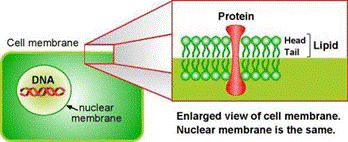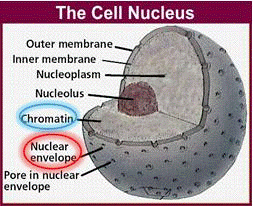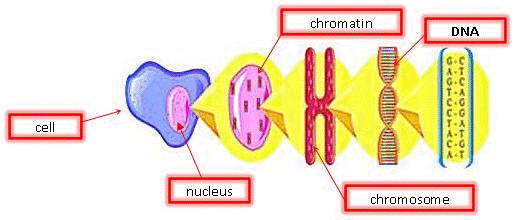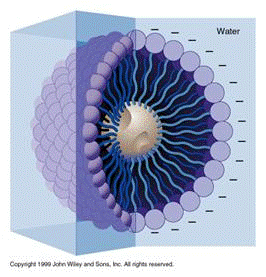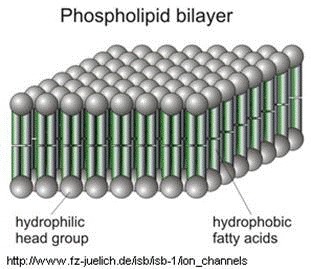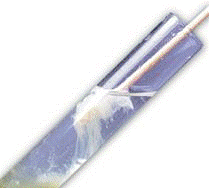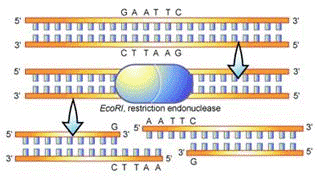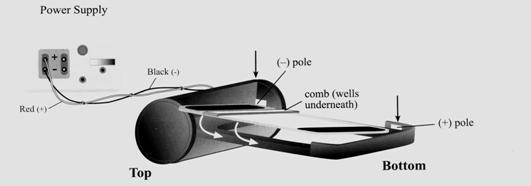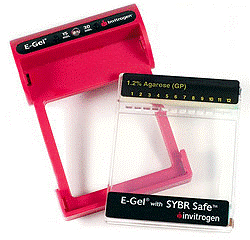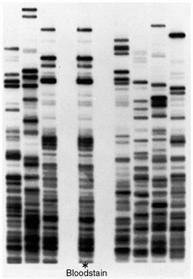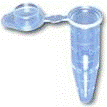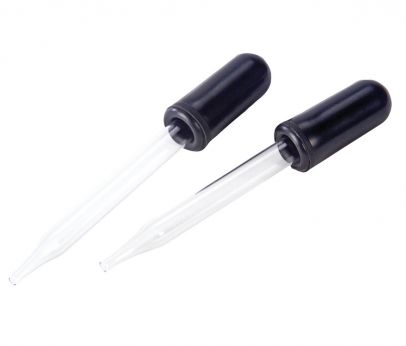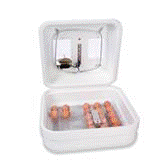Difference between revisions of "DNA Extraction and Gel Analysis"
| Line 51: | Line 51: | ||
<p>The DNA molecule is a double-helical polymer consisting of a sugar-phosphate backbone with nitrogenous bases running perpendicular to the backbone. These bases, often represented by letters — <b>A (adenine), G (guanine), C (cytosine) and T (thymine)</b> — are the elementary components making up the coded genetic information. The base sequence acts as the instruction manual of the cell, directing it on how to <b>make proteins, and other important molecules that an organism needs to survive and function</b>.</p> | <p>The DNA molecule is a double-helical polymer consisting of a sugar-phosphate backbone with nitrogenous bases running perpendicular to the backbone. These bases, often represented by letters — <b>A (adenine), G (guanine), C (cytosine) and T (thymine)</b> — are the elementary components making up the coded genetic information. The base sequence acts as the instruction manual of the cell, directing it on how to <b>make proteins, and other important molecules that an organism needs to survive and function</b>.</p> | ||
<p>With the cell's contents mixed into a solution, the DNA needs to be separated from the rest; this process is called <b>precipitation</b>. We use salt because it disrupts the structure of the proteins and carbohydrates found in the solution. Also, the salt provides a favorable environment to extract the DNA by contributing positively charged sodium ions which neutralize the negative charge of DNA. | <p>With the cell's contents mixed into a solution, the DNA needs to be separated from the rest; this process is called <b>precipitation</b>. We use salt because it disrupts the structure of the proteins and carbohydrates found in the solution. Also, the salt provides a favorable environment to extract the DNA by contributing positively charged sodium ions which neutralize the negative charge of DNA. However, even after the addition of salt and soap, we cannot see how it is physically extracting the DNA out of the solution as it is too small for us to distinguish it from the rest of the solution. To aide in precipitating the DNA, alcohol is added since it cannot dissolve DNA. A translucent white substance will begin to form at the top; this is our DNA. Once it is thick enough, we will spool it out. This simple procedure is a rough extraction process which needs further purification before it can be successfully run on a gel for analysis.</p> | ||
<p align="center">[[Image:DNA5.gif]]</p> | <p align="center">[[Image:DNA5.gif]]</p> | ||
| Line 204: | Line 204: | ||
<li>Add ice-cold alcohol to the filtered solution by pouring the alcohol against the wall of the cup. We do not want the alcohol to mix with the solution; we want it to float on top. Alcohol dissolves within water but IT CAN FLOAT IF IT IS POURED SLOWLY AGAINST THE WALL OF THE CONTAINER because it is less dense than water. Pour the alcohol until the total volume reaches 3/4 of the cup’s volume. After about one minute, you will see threads of DNA forming into translucent gel-like globs at the interface of the filtered solution and the alcohol.</li> | <li>Add ice-cold alcohol to the filtered solution by pouring the alcohol against the wall of the cup. We do not want the alcohol to mix with the solution; we want it to float on top. Alcohol dissolves within water but IT CAN FLOAT IF IT IS POURED SLOWLY AGAINST THE WALL OF THE CONTAINER because it is less dense than water. Pour the alcohol until the total volume reaches 3/4 of the cup’s volume. After about one minute, you will see threads of DNA forming into translucent gel-like globs at the interface of the filtered solution and the alcohol.</li> | ||
<li>Collect the DNA by spooling it with a paperclip.</li> | <li>Collect the DNA by spooling it with a paperclip.</li> | ||
What is collected consists of sugars and other | </ol> | ||
<p>What is collected consists of sugars and other "junk" as well as the DNA of the fruit itself. To properly run it through the electrophoresis gel and get results, we would have to size it down considerably and thoroughly rinse it to get rid of the excess layers. Since we do not have the proper equipment to do so, we will run Lambda DNA, which is already prepared and able to run in the electrophoresis gel.</p> | |||
<ol> | |||
<li>Load the micropipette with a tip and obtain 4 µL of the lambda DNA using the micropipette.</li> | <li>Load the micropipette with a tip and obtain 4 µL of the lambda DNA using the micropipette.</li> | ||
<li>Pipe it into a microcentrifuge tube and dispose of the micropipette tip. You will need to dispose of the tip after one use.</li> | <li>Pipe it into a microcentrifuge tube and dispose of the micropipette tip. You will need to dispose of the tip after one use.</li> | ||
| Line 211: | Line 213: | ||
<li>Add 8 µL of distilled water.</li> | <li>Add 8 µL of distilled water.</li> | ||
<li>Add 1 µL of dye. This will allow us to see the DNA as it runs through the gel. After this is done, call the TA.</li> | <li>Add 1 µL of dye. This will allow us to see the DNA as it runs through the gel. After this is done, call the TA.</li> | ||
The TA will guide you with the rest of the procedure. | </ol> | ||
<p>The TA will guide you with the rest of the procedure.</p> | |||
<ol> | |||
<li>Place the microcentrifuge tube into the incubator. It should be set to 37 °C. The sample will incubate for 30 minutes.</li> | <li>Place the microcentrifuge tube into the incubator. It should be set to 37 °C. The sample will incubate for 30 minutes.</li> | ||
<li>Prepare electrophoresis gel when there are 15 minutes left for the incubation. | <li>Prepare electrophoresis gel when there are 15 minutes left for the incubation. | ||
Revision as of 21:33, 29 March 2009
DNA EXTRACTION AND GEL ANALYSIS
1 OBJECTIVES
The objective of this experiment is to extract DNA from a fruit and view the banding pattern formed when the samples are run through a gel matrix. In doing so, you will also learn where DNA is located, how to get to it and extract it. Basic biochemical techniques will be introduced to allow you to isolate, purify, and digest DNA molecules.
You will also learn how to perform a restriction digest of Lambda DNA and visualize the difference in the banding pattern between unrestricted and partially restricted Lambda DNA. This will be achieved by running gel electrophoresis, which separates DNA fragments by their respective molecular weights.
2 OVERVIEW
Cellular Biology and Location of DNA
DNA is the blueprint of life and is found in all living organisms. These organisms can be as simple as a single-celled bacteria or as complex as a multi-celled human: the human body contains approximately 50 trillion cells. There are two different types of cells: prokaryotes and eukaryotes. An example of prokaryotic organism is bacteria. Prokaryotic cells do not contain a nuclear membrane and thus do not have a distinct nucleus. In this experiment, we are only interested in eukaryotic cells, which make up plants and animals. Eukaryotic cells have a distinct, membrane-bound nucleus that isolates the DNA from the rest of the cell. The structure of plant cells is different from those of animal cells in structure and cellular contents. We will only be dealing with plant cells in this experiment.
Plant cells are surrounded by a cell wall. It has high mechanical strength and protects the cell. Directly beneath the cell wall lies the plasma membrane, which contains the cytosol. The various cell organelles, including the nucleus, is found within the cytosol. The nucleus is of particular interest to us since it houses the DNA in the form of chromatin.
Chromatin is the active form of DNA in the cell when it is not preparing for cell division. It is comprised of DNA wrapped around protein particles called histones.
DNA Extraction Technique
In this experiment, one of our goals is to extract the DNA from the fruit sample. Below, we will describe the scientific background behind DNA extraction.
The DNA extraction process is a fairly simple biochemical procedure that can be divided into three major steps: breaking open the cell (lysis), destroying membranes within the cell, and precipitating the DNA out of the solution.
We will describe in the section below how each step relates to the physical and biochemical properties of DNA.
Cell Lysis (Breaking Open the Cell Wall and Membranes)
We have mentioned earlier that plant cells have a very rigid external structure — the cell wall — which protects it. To get to the DNA, the very first step would be to break open that wall.
The cell wall is the first barrier in our journey towards the DNA molecule inside the cell. It is very rigid and acts as a protector and filter. It is made of cellulose, and is responsible for making wood hard and durable. To destroy the cell wall, we need some mechanical means in order to break apart the cellulose molecules. In our experiment, we will mash the fruit manually.
Destroying Membranes Within the Cell
To effectively break into an organized structure, a basic understanding of its composition and structure is required. For example, different techniques are considered to break through a steel gate versus a wooden gate. We can apply a similar approach to this problem. The cell's plasma membrane is made of phospholipid bilayers. Don't mind the scary biochemistry term. Suffice it to say, they’re made of fat. To disrupt them, we need to break apart that mesh of fat molecules. For this purpose we use the archenemy of fat and grease: soap! Interestingly enough, the structure of soap is very similar to that of fat and grease, which allows us to exploit the structure of soap to break down grease on our plates. An easy way to remember this is "like dissolves like."
A soap molecule has two parts: a head and a tail. The head is polar and is therefore attracted to water while the tail is non-polar and is attracted to oil and fat. When soap molecules are in water, they group themselves into micelles — a roughly spherical structure in which all the water-loving heads point outwards (in contact with water) and all the fat-loving tails point inwards at the center of the sphere (away from the water). Therefore they can effectively trap the fat molecule inside the micelle and dissolve the cell membranes. How does this micelle break down the phospholipid bilayer? The molecules in the phospholipid bilayer also contain molecules that are made up of a hydrophobic (fat loving) head and a hydrophilic (water loving) tail. The soap molecules orient themselves so that their head associates with the tail of the phospholipid bilayer. In this way, the soap is able to break up the bilayer molecule by molecule.
Precipitating the DNA
When the membrane is successfully disrupted, the DNA is released from the cells into the solution along with protein molecules and other cellular miscellanea.
The DNA molecule is a double-helical polymer consisting of a sugar-phosphate backbone with nitrogenous bases running perpendicular to the backbone. These bases, often represented by letters — A (adenine), G (guanine), C (cytosine) and T (thymine) — are the elementary components making up the coded genetic information. The base sequence acts as the instruction manual of the cell, directing it on how to make proteins, and other important molecules that an organism needs to survive and function.
With the cell's contents mixed into a solution, the DNA needs to be separated from the rest; this process is called precipitation. We use salt because it disrupts the structure of the proteins and carbohydrates found in the solution. Also, the salt provides a favorable environment to extract the DNA by contributing positively charged sodium ions which neutralize the negative charge of DNA. However, even after the addition of salt and soap, we cannot see how it is physically extracting the DNA out of the solution as it is too small for us to distinguish it from the rest of the solution. To aide in precipitating the DNA, alcohol is added since it cannot dissolve DNA. A translucent white substance will begin to form at the top; this is our DNA. Once it is thick enough, we will spool it out. This simple procedure is a rough extraction process which needs further purification before it can be successfully run on a gel for analysis.
Restriction
Often times, larger fragments of DNA are cut, or restricted, to extract a particular fragment. This is made possible by the action of restriction enzymes, which are used by bacteria to cut up foreign or enemy DNA. Restriction enzymes are catalytic proteins that recognize specific palindromic DNA sequences and cut the double-stranded DNA at particular sites. The sites that the restriction enzymes recognize are called restriction sites. There are many different types of restriction enzymes. Each type recognizes a different restriction site. In this lab, we will restrict Lambda DNA, which is a commercially available DNA normally found in a virus called Phage Lambda. We will use the restriction enzyme BamH1.
| Enzyme | Source | Recognition Sequence | Cut | |
|---|---|---|---|---|
| BamH1 | Bacillus amyloliquefaciens | 5'GGATCC 3'CCTAGG |
5'-----G -------CCTAG |
GATCC------ G-----5' |
| EcoRI | Escherichia coli | 5'GGATCC 3'CCTAGG |
5'-----G -------CCTAG |
GATCC------ G-----5' |
| HindIII | Haemophilus influenzae | 5'AAGCTT 3'TTCGAA |
5'---A 3'---TTCGA |
AGCTT---3' A---5' |
Gel Electrophoresis
To learn the technique of DNA electrophoresis, we will run our uncut and cut Lambda DNA, a commercially available DNA on an agarose gel, to visualize the characteristic banding patterns that can help us differentiate between different DNA fragments. Gel electrophoresis is a technique used for separating molecules based on their charge and molecular weight. The sample is loaded in a gel matrix and an electric field is applied across it. The electric field enables the DNA, which is negatively charged to migrate to the end, which is positively charged. Remember, opposites attract and so the negatively charged DNA is attracted to the positive end of the gel. What causes different sized DNA to separate into different bands? Lighter molecules will migrate to the opposite end of the gel faster than heavier molecules. The situation is analogous to swimmers in a swimming pool. The lighter swimmer is able to move faster than the heavier ones and is more likely to reach the end first.
The following is a gel after the samples have been run. Each column is referred to as a lane, representing one sample each. The individual bands contain fragments of DNA that are identical in weight.
3 Your Assignment
Individual Lab Report
Follow the lab report guidelines laid out in the page called Specifications for Writing Your Lab Reports in the Technical Communication section of this manual. As you write, the following discussion points should be addressed in the appropriate section of your lab report:
- Justify the use of salt, soap, and alcohol in the extraction procedure.
- Explain how to reach the DNA and the barriers that were overcome to get to it.
- Describe the major techniques used in this lab: Gel Electrophoresis, DNA Digestion, etc.
- Explain why the incubator was used.
- Important properties of DNA directly having an impact on the extraction procedure.
- Clearly describe the procedural steps the way they were carried out in lab.
- Describe the steps carried out with the TA.
- Describe how the banding pattern is obtained.
- Explain why the banding pattern aids in identifying a specific fruit sample.
4 Materials and Equipment
5 Procedure
- Obtain a fruit sample that is about 2 inches wide and put the it in the Ziploc bag provided.
- Close the bag so there is as little air as possible inside.
- Mash the sample gently with your hands. Be careful not to burst the bag to avoid a big mess! After about 5 minutes, the fruit sample will be transformed into a creamy paste. This process is known as homogenization.
- Prepare the buffer solution while one team member is working on the homogenization of the fruit sample.
- Fill a cup halfway with distilled water.
- Add one teaspoon of table salt.
- Mix the solution until the salt dissolves in the water.
- Add 3 teaspoons of soap.
- Stir gently with the spoon so that it doesn’t foam. Keep stirring until the texture of the solution is even.
- Pour the prepared buffer solution into the Ziploc bag and close it. Make sure you haven’t trapped air in the bag.
- Mix the smashed fruit and the buffer solution gently in the bag. Do it slowly. It is important that it does not foam a lot.
- Let the mixture sit for about 5 minutes. If it has foamed, allow the foam to go away during this time. By letting the mixture stay still, the foam will disappear.
- Filter the solution by using another clear plastic cup. One team member should hold the cheesecloth on top of the empty cup while another carefully pours out the contents of the Ziploc bag. Make sure it does not foam. Pour slowly! Occasionally shake the cheesecloth to make to liquid filter through. There is a lot of debris.
- Raise the edges of the cheesecloth, and squeeze the remaining liquid out and into the rest of the filtered solution.
- Add ice-cold alcohol to the filtered solution by pouring the alcohol against the wall of the cup. We do not want the alcohol to mix with the solution; we want it to float on top. Alcohol dissolves within water but IT CAN FLOAT IF IT IS POURED SLOWLY AGAINST THE WALL OF THE CONTAINER because it is less dense than water. Pour the alcohol until the total volume reaches 3/4 of the cup’s volume. After about one minute, you will see threads of DNA forming into translucent gel-like globs at the interface of the filtered solution and the alcohol.
- Collect the DNA by spooling it with a paperclip.
What is collected consists of sugars and other "junk" as well as the DNA of the fruit itself. To properly run it through the electrophoresis gel and get results, we would have to size it down considerably and thoroughly rinse it to get rid of the excess layers. Since we do not have the proper equipment to do so, we will run Lambda DNA, which is already prepared and able to run in the electrophoresis gel.
- Load the micropipette with a tip and obtain 4 µL of the lambda DNA using the micropipette.
- Pipe it into a microcentrifuge tube and dispose of the micropipette tip. You will need to dispose of the tip after one use.
- Reload the micropipette with another tip and obtain 5 µL of the restriction buffer. Dispose of the tip.
- Get another tip and get 2 µL of BamH1, which is the restriction enzyme used to cut the DNA. Dispose of the tip.
- Add 8 µL of distilled water.
- Add 1 µL of dye. This will allow us to see the DNA as it runs through the gel. After this is done, call the TA.
The TA will guide you with the rest of the procedure.
- Place the microcentrifuge tube into the incubator. It should be set to 37 °C. The sample will incubate for 30 minutes.
- Prepare electrophoresis gel when there are 15 minutes left for the incubation.
- Plug the power base in.
- Open the package containing the gel.
- Insert the gel, right edge first, and press firmly at the top and bottom to seat the gel in the base. You will hear a snap when it is in place. A steady red light will appear.
- Press and hold either button until the red light turns into a flashing green light. This indicates that the 2 minute pre-run of the gel has started. At the end of the pre-run, the flashing green light will change to a flashing red light and the base will rapidly beep.
- Press and release either button to stop the beeping. You will hear one more beep. The light will change from a flashing red to a steady red light.
- Remove the comb from the gel by pulling it straight up from both sides and remove any excess fluid using a pipette.
- Load the samples in 20 µL volumes into the wells. Load 20 µL of distilled water into any remaining empty wells.
- Press and release the 30 minute button to start the 30 minute electrophoresis run. The light will change to a steady green light.
- Wait 30 minutes for the run to complete. The light will flash red and there will be a rapid beeping.
- Press and release either button to stop the beeping and the light will turn to a steady red light.
- Remove the gel from the base and analyze the results using a UV transilluminator.
6 References
Nasco Website
The Science Creative Quarterly
http://www.hhmi.princeton.edu/documents/labprotocols
http://porpax.bio.miami.edu/~cmallery/255/255chem/255chemistry.htm
